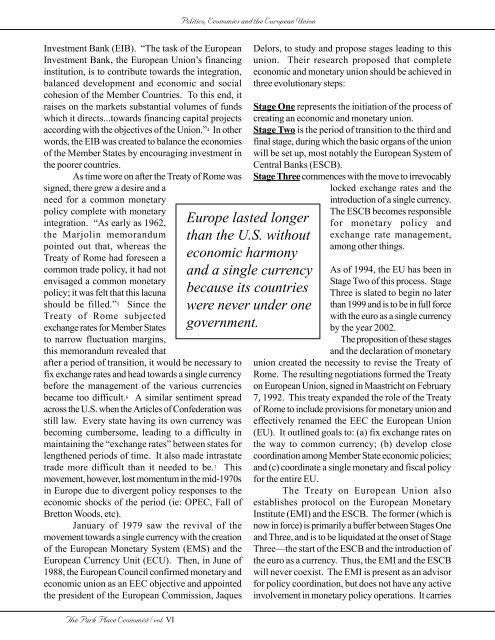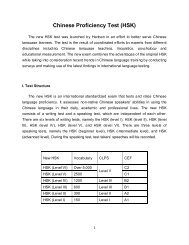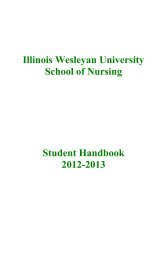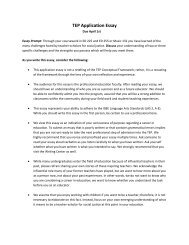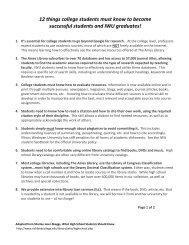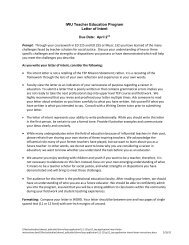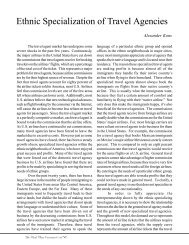Politics, Economics and the European Union
Politics, Economics and the European Union
Politics, Economics and the European Union
You also want an ePaper? Increase the reach of your titles
YUMPU automatically turns print PDFs into web optimized ePapers that Google loves.
<strong>Politics</strong>, <strong>Economics</strong> <strong>and</strong> <strong>the</strong> <strong>European</strong> <strong>Union</strong><br />
Investment Bank (EIB). “The task of <strong>the</strong> <strong>European</strong><br />
Investment Bank, <strong>the</strong> <strong>European</strong> <strong>Union</strong>’s financing<br />
institution, is to contribute towards <strong>the</strong> integration,<br />
balanced development <strong>and</strong> economic <strong>and</strong> social<br />
cohesion of <strong>the</strong> Member Countries. To this end, it<br />
raises on <strong>the</strong> markets substantial volumes of funds<br />
which it directs...towards financing capital projects<br />
according with <strong>the</strong> objectives of <strong>the</strong> <strong>Union</strong>.” 4 In o<strong>the</strong>r<br />
words, <strong>the</strong> EIB was created to balance <strong>the</strong> economies<br />
of <strong>the</strong> Member States by encouraging investment in<br />
<strong>the</strong> poorer countries.<br />
As time wore on after <strong>the</strong> Treaty of Rome was<br />
signed, <strong>the</strong>re grew a desire <strong>and</strong> a<br />
need for a common monetary<br />
policy complete with monetary<br />
integration. “As early as 1962,<br />
<strong>the</strong> Marjolin memor<strong>and</strong>um<br />
pointed out that, whereas <strong>the</strong><br />
Treaty of Rome had foreseen a<br />
common trade policy, it had not<br />
envisaged a common monetary<br />
policy; it was felt that this lacuna<br />
should be filled.” 5 Since <strong>the</strong><br />
Treaty of Rome subjected<br />
exchange rates for Member States<br />
to narrow fluctuation margins,<br />
this memor<strong>and</strong>um revealed that<br />
after a period of transition, it would be necessary to<br />
fix exchange rates <strong>and</strong> head towards a single currency<br />
before <strong>the</strong> management of <strong>the</strong> various currencies<br />
became too difficult. 6 A similar sentiment spread<br />
across <strong>the</strong> U.S. when <strong>the</strong> Articles of Confederation was<br />
still law. Every state having its own currency was<br />
becoming cumbersome, leading to a difficulty in<br />
maintaining <strong>the</strong> “exchange rates” between states for<br />
leng<strong>the</strong>ned periods of time. It also made intrastate<br />
trade more difficult than it needed to be. 7 This<br />
movement, however, lost momentum in <strong>the</strong> mid-1970s<br />
in Europe due to divergent policy responses to <strong>the</strong><br />
economic shocks of <strong>the</strong> period (ie: OPEC, Fall of<br />
Bretton Woods, etc).<br />
January of 1979 saw <strong>the</strong> revival of <strong>the</strong><br />
movement towards a single currency with <strong>the</strong> creation<br />
of <strong>the</strong> <strong>European</strong> Monetary System (EMS) <strong>and</strong> <strong>the</strong><br />
<strong>European</strong> Currency Unit (ECU). Then, in June of<br />
1988, <strong>the</strong> <strong>European</strong> Council confirmed monetary <strong>and</strong><br />
economic union as an EEC objective <strong>and</strong> appointed<br />
<strong>the</strong> president of <strong>the</strong> <strong>European</strong> Commission, Jaques<br />
The Park Place Economist / vol. VI<br />
Europe lasted longer<br />
than <strong>the</strong> U.S. without<br />
economic harmony<br />
<strong>and</strong> a single currency<br />
because its countries<br />
were never under one<br />
government.<br />
Delors, to study <strong>and</strong> propose stages leading to this<br />
union. Their research proposed that complete<br />
economic <strong>and</strong> monetary union should be achieved in<br />
three evolutionary steps:<br />
Stage One represents <strong>the</strong> initiation of <strong>the</strong> process of<br />
creating an economic <strong>and</strong> monetary union.<br />
Stage Two is <strong>the</strong> period of transition to <strong>the</strong> third <strong>and</strong><br />
final stage, during which <strong>the</strong> basic organs of <strong>the</strong> union<br />
will be set up, most notably <strong>the</strong> <strong>European</strong> System of<br />
Central Banks (ESCB).<br />
Stage Three commences with <strong>the</strong> move to irrevocably<br />
locked exchange rates <strong>and</strong> <strong>the</strong><br />
introduction of a single currency.<br />
The ESCB becomes responsible<br />
for monetary policy <strong>and</strong><br />
exchange rate management,<br />
among o<strong>the</strong>r things.<br />
As of 1994, <strong>the</strong> EU has been in<br />
Stage Two of this process. Stage<br />
Three is slated to begin no later<br />
than 1999 <strong>and</strong> is to be in full force<br />
with <strong>the</strong> euro as a single currency<br />
by <strong>the</strong> year 2002.<br />
The proposition of <strong>the</strong>se stages<br />
<strong>and</strong> <strong>the</strong> declaration of monetary<br />
union created <strong>the</strong> necessity to revise <strong>the</strong> Treaty of<br />
Rome. The resulting negotiations formed <strong>the</strong> Treaty<br />
on <strong>European</strong> <strong>Union</strong>, signed in Maastricht on February<br />
7, 1992. This treaty exp<strong>and</strong>ed <strong>the</strong> role of <strong>the</strong> Treaty<br />
of Rome to include provisions for monetary union <strong>and</strong><br />
effectively renamed <strong>the</strong> EEC <strong>the</strong> <strong>European</strong> <strong>Union</strong><br />
(EU). It outlined goals to: (a) fix exchange rates on<br />
<strong>the</strong> way to common currency; (b) develop close<br />
coordination among Member State economic policies;<br />
<strong>and</strong> (c) coordinate a single monetary <strong>and</strong> fiscal policy<br />
for <strong>the</strong> entire EU.<br />
The Treaty on <strong>European</strong> <strong>Union</strong> also<br />
establishes protocol on <strong>the</strong> <strong>European</strong> Monetary<br />
Institute (EMI) <strong>and</strong> <strong>the</strong> ESCB. The former (which is<br />
now in force) is primarily a buffer between Stages One<br />
<strong>and</strong> Three, <strong>and</strong> is to be liquidated at <strong>the</strong> onset of Stage<br />
Three—<strong>the</strong> start of <strong>the</strong> ESCB <strong>and</strong> <strong>the</strong> introduction of<br />
<strong>the</strong> euro as a currency. Thus, <strong>the</strong> EMI <strong>and</strong> <strong>the</strong> ESCB<br />
will never coexist. The EMI is present as an advisor<br />
for policy coordination, but does not have any active<br />
involvement in monetary policy operations. It carries


